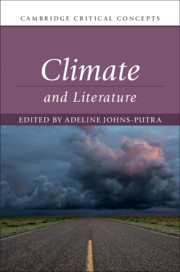Book contents
- Climate and Literature
- Cambridge Critical Concepts
- Climate and Literature
- Copyright page
- Contents
- Illustrations
- Contributors
- Acknowledgements
- Introduction
- Part I Origins
- Chapter 1 Literature, Climate, and Time: Between History and Story
- Chapter 2 Atmosphere as Setting, or, ‘Wuthering’ the Anthropocene
- Chapter 3 The Seasons
- Chapter 4 Climatic Agency in the Classical Age
- Chapter 5 Weathering the Storm: Adverse Climates in Medieval Literature
- Chapter 6 The Climate of Shakespeare: Four (or More) Forecasts
- Part II Evolution
- Part III Application
- Bibliography
- Index
Chapter 5 - Weathering the Storm: Adverse Climates in Medieval Literature
from Part I - Origins
Published online by Cambridge University Press: 31 July 2019
- Climate and Literature
- Cambridge Critical Concepts
- Climate and Literature
- Copyright page
- Contents
- Illustrations
- Contributors
- Acknowledgements
- Introduction
- Part I Origins
- Chapter 1 Literature, Climate, and Time: Between History and Story
- Chapter 2 Atmosphere as Setting, or, ‘Wuthering’ the Anthropocene
- Chapter 3 The Seasons
- Chapter 4 Climatic Agency in the Classical Age
- Chapter 5 Weathering the Storm: Adverse Climates in Medieval Literature
- Chapter 6 The Climate of Shakespeare: Four (or More) Forecasts
- Part II Evolution
- Part III Application
- Bibliography
- Index
Summary
Literary representations of climate come in a range of forms, informed as much by culture as by physical conditions. The interregional applicability of climate motifs has implications for their dissemination, as narratives relying on specific environmental variables may tend to spread less widely unless they are read as accounts of the exotic. This chapter introduces responses to climate in medieval European literature by examining one motif at either extreme of the universality spectrum. Icelandic prose responds to Iceland’s short growing season by rooting many of its feuds in tensions over natural resources, with a prominent role for hay as the island’s most productive crop. At the other extreme, homiletic accounts of end-time climate describe conditions beyond anyone’s experience but made universally relatable by way of an analogy between world history and human ageing.
- Type
- Chapter
- Information
- Climate and Literature , pp. 76 - 91Publisher: Cambridge University PressPrint publication year: 2019

